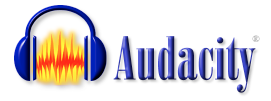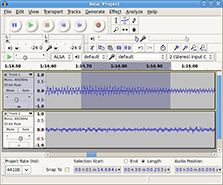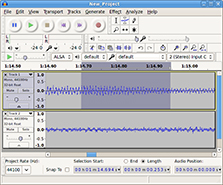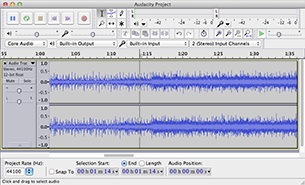Carpenter, Taylor M.
From DigitalRhetoricCollaborative
(→Audacity) |
(→Audacity) |
||
| Line 12: | Line 12: | ||
| - | Audacity is a freeware, open source, cross platform software for recording and editing audio. <ref>http://web.audacityteam.org/about/, Audacity Home Page</ref> Audacity can record live audio, record computer playback on any Windows Vista or later machine. It can also convert tapes and records into digital recordings or CDs, edit WAV, AIFF, FLAC, MP2, MP3 or Ogg Vorbis sound files. In addition, AC3, M4A/M4R (AAC), WMA and other formats are supported using optional libraries. Users can copy cut, splice or mix sounds together, numerous effects including changing the speed or pitch of a recording.” <ref>http://web.audacityteam.org/about/Audacity About Page</ref> Several university English departments use Audacity in teaching subjects like digital writing,<ref>http://digitalwriting101.net/content/how-to-use-audacity-to-record-audio/, Goodloe, Amy, Digital Writing 101, HOW TO-Use Audacity to record audio</ref> and rhetoric class <ref>http://rhetoric.olemiss.edu/student/multimodal/audio/, The University of Mississippi, Department of Writing and Rhetoric, Audio Project</ref> when exploring digital and multimodal composition. Furthermore, the program is featured in the section about creating and editing audio and video in ''Digital Literacy for Dummies.''<ref>https://books.google.com/books?id=hLntAwAAQBAJ&pg=PA387&lpg=PA387&dq=audacity+and+digital+literacy&source=bl&ots=vNrTGBxMEI&sig=D4jK_huL5pUrBi4-U0gjlZq6ZN4&hl=en&sa=X&ei=UbI4Vdq1LoLpsAWI54D4BQ&ved=0CD4Q6AEwBQ#v=onepage&q=audacity%20and%20digital%20literacy&f=false, Wempen, Faither''Digital Literacy for Dummies,'' 387</ref> | + | Audacity is a freeware, open source, cross platform software for recording and editing audio. <ref>http://web.audacityteam.org/about/, Audacity Home Page</ref> Audacity can record live audio, record computer playback on any Windows Vista or later machine. It can also convert tapes and records into digital recordings or CDs, edit WAV, AIFF, FLAC, MP2, MP3 or Ogg Vorbis sound files. In addition, AC3, M4A/M4R (AAC), WMA and other formats are supported using optional libraries. Users can copy cut, splice or mix sounds together, numerous effects including changing the speed or pitch of a recording.” <ref>http://web.audacityteam.org/about/Audacity About Page</ref> Several university English departments use Audacity in teaching subjects like digital writing,<ref>http://digitalwriting101.net/content/how-to-use-audacity-to-record-audio/, Goodloe, Amy, Digital Writing 101, HOW TO-Use Audacity to record audio</ref> and rhetoric class <ref>http://rhetoric.olemiss.edu/student/multimodal/audio/, The University of Mississippi, Department of Writing and Rhetoric, Audio Project</ref> when exploring digital and multimodal composition. Furthermore, the program is featured in the section about creating and editing audio and video in ''Digital Literacy for Dummies.''<ref>https://books.google.com/books?id=hLntAwAAQBAJ&pg=PA387&lpg=PA387&dq=audacity+and+digital+literacy&source=bl&ots=vNrTGBxMEI&sig=D4jK_huL5pUrBi4-U0gjlZq6ZN4&hl=en&sa=X&ei=UbI4Vdq1LoLpsAWI54D4BQ&ved=0CD4Q6AEwBQ#v=onepage&q=audacity%20and%20digital%20literacy&f=false, Wempen, Faither''Digital Literacy for Dummies,'' 387</ref> Audacity facilitates a new, and easily accessible form of storytelling in today's digital society. |
Revision as of 03:59, 23 April 2015
Audacity
Audacity is a freeware, open source, cross platform software for recording and editing audio. [1] Audacity can record live audio, record computer playback on any Windows Vista or later machine. It can also convert tapes and records into digital recordings or CDs, edit WAV, AIFF, FLAC, MP2, MP3 or Ogg Vorbis sound files. In addition, AC3, M4A/M4R (AAC), WMA and other formats are supported using optional libraries. Users can copy cut, splice or mix sounds together, numerous effects including changing the speed or pitch of a recording.” [2] Several university English departments use Audacity in teaching subjects like digital writing,[3] and rhetoric class [4] when exploring digital and multimodal composition. Furthermore, the program is featured in the section about creating and editing audio and video in Digital Literacy for Dummies.[5] Audacity facilitates a new, and easily accessible form of storytelling in today's digital society.
Contents |
Editing
- Editing with Cut, Copy, Paste-very similar to copy and pasting in Word
- Unlimited sequential undo and redo
- Can edit and mix many tracks
- Can label tracks
- Sync-Lock Tracks feature for keeping tracks and labels synchronized
- Change individual sample points with the Draw Tool
- Envelope tool allows user to fade the volume up or down
- Automatic Crash Recover [6]
Freeware
“One reason Audacity is free is so that it will be more popular and useful. Yet another reason is to encourage collaboration. Because of Audacity's free license, dozens of people around the world have contributed code, bug fixes, documentation, and graphics.”
Audacity is a completely free, and open source software that people can download for whatever purpose they want (educational, commercial, or personal), people can sell and modify it as they wish as well.
-A not-for-profit volunteer group developed Audicity and the source code is available for people to use. The authors released it under a general public license for different reasons.
“Some of us do it out of generosity. Some of us do it for moral reasons, because we feel that all software should be free; others believe that there is a place for both free and proprietary software.” [7]
-Can tie this all back to digital rhetoric-coding and developing software is a new form of writing in a way, and these people what to share their work for free in order to encourage discourse on their software-the problem is that I’m not sure if this analysis would be considered biased or “new research” or something along those lines.
Adoption/Reception
-Michael Murchmore of "PC Mag" describes Audacity in a review as “Audacity is a surprisingly full-featured audio recording and editing software package considering it's free and open source.” He does also say, however that like a lot of freeware it is not necessary user friendly, because it focuses more on what it can do.[8]
References
- ↑ http://web.audacityteam.org/about/, Audacity Home Page
- ↑ http://web.audacityteam.org/about/Audacity About Page
- ↑ http://digitalwriting101.net/content/how-to-use-audacity-to-record-audio/, Goodloe, Amy, Digital Writing 101, HOW TO-Use Audacity to record audio
- ↑ http://rhetoric.olemiss.edu/student/multimodal/audio/, The University of Mississippi, Department of Writing and Rhetoric, Audio Project
- ↑ https://books.google.com/books?id=hLntAwAAQBAJ&pg=PA387&lpg=PA387&dq=audacity+and+digital+literacy&source=bl&ots=vNrTGBxMEI&sig=D4jK_huL5pUrBi4-U0gjlZq6ZN4&hl=en&sa=X&ei=UbI4Vdq1LoLpsAWI54D4BQ&ved=0CD4Q6AEwBQ#v=onepage&q=audacity%20and%20digital%20literacy&f=false, Wempen, FaitherDigital Literacy for Dummies, 387
- ↑ http://web.audacityteam.org/about/features Audacity About Page
- ↑ http://manual.audacityteam.org/o/man/faq_about_audacity.html#free. Audacity Wiki: FAQ: About Audacity
- ↑ http://www.pcmag.com/article2/0%2c2817%2c2358860%2c00.asp, Audacity 1.2





